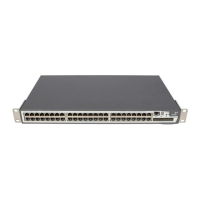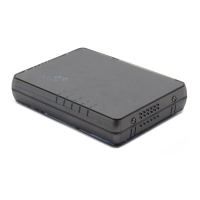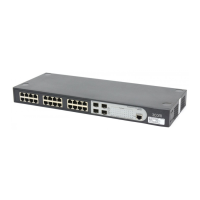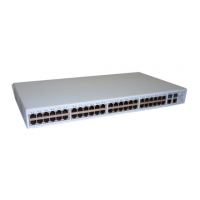1-3
To do... Use the command... Remarks
Limit broadcast traffic received
on each port
broadcast-suppression { ratio
| pps max-pps }
Optional
By default, the switch does not
suppress broadcast traffic.
Enter Ethernet port view
interface interface-type
interface-number
—
Limit broadcast traffic received
on the current port
broadcast-suppression { ratio
| pps max-pps }
Optional
By default, the switch does not
suppress broadcast traffic.
Limit multicast traffic received
on the current port
multicast-suppression { ratio |
pps max-pps }
Optional
By default, the switch does not
suppress multicast traffic.
Limit unknown unicast traffic
received on the current port
unicast-suppression { ratio |
pps max-pps }
Optional
By default, the switch does not
suppress unknown unicast
traffic.
Configuring Flow Control on a Port
In situations where the receiving port is unable to process received frames, you can use the flow control
function to enable the receiving port to inform the sending port to stop sending the frames for a while,
thus preventing frames from being dropped.
The flow control function is implemented on a port by sending and receiving pause frames. Flow control
operates in one of the following two modes on a port:
z TxRx mode, where the port can receive and send pause frames.
z Rx mode, where the port only can receive pause frames.
In
0, when both Port A and Port B forward packets at 1000 Mbps, Port C is congested. To avoid packet
loss, you can enable flow control on Port A, and Port B.
Figure 1-1 Configure flow control on a port
Configure flow control in TxRx mode on Port B, and flow control in Rx mode on Port A:
z When congestions occur on Port C, Switch B buffers the frames. When the amount of the buffered
frames exceeds a certain value, Switch B can realize that the traffic from Port B to Port C is too
heavy and exceeds the forwarding capacity of Port C. As a result, Port B in TxRx mode sends
pause frames to Port A to inform Port A to suspend packet sending.
z Upon receiving the pause frames from Port B, Port A suspends sending packets to Port B.
z When part of the buffered frames of Switch B are sent out Port C and the amount of the buffered
frames drops to a certain level, Port B sends traffic recovery frames to Port A to inform Port A to
resume frame sending. Thus, packet loss on Port C is avoided.
Follow these steps to configure flow control on a port:

